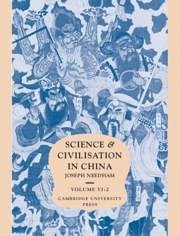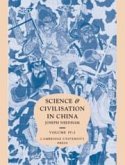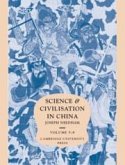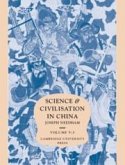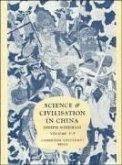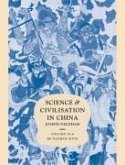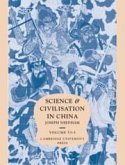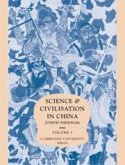- Gebundenes Buch
- Merkliste
- Auf die Merkliste
- Bewerten Bewerten
- Teilen
- Produkt teilen
- Produkterinnerung
- Produkterinnerung
This second part of the sixth volume of Joeph Needham's great enterprise is an account of the technological history of Chinese agriculture.
Andere Kunden interessierten sich auch für
![Science and Civilisation in China, Part 2, Mechanical Engineering Science and Civilisation in China, Part 2, Mechanical Engineering]() Joseph NeedhamScience and Civilisation in China, Part 2, Mechanical Engineering453,99 €
Joseph NeedhamScience and Civilisation in China, Part 2, Mechanical Engineering453,99 €![Science and Civilisation in China, Part 9, Textile Technology: Spinning and Reeling Science and Civilisation in China, Part 9, Textile Technology: Spinning and Reeling]() Joseph NeedhamScience and Civilisation in China, Part 9, Textile Technology: Spinning and Reeling372,99 €
Joseph NeedhamScience and Civilisation in China, Part 9, Textile Technology: Spinning and Reeling372,99 €![Science and Civilisation in China, Part 3, Spagyrical Discovery and Invention: Historical Survey from Cinnabar Elixirs to Synthetic Insulin Science and Civilisation in China, Part 3, Spagyrical Discovery and Invention: Historical Survey from Cinnabar Elixirs to Synthetic Insulin]() Joseph NeedhamScience and Civilisation in China, Part 3, Spagyrical Discovery and Invention: Historical Survey from Cinnabar Elixirs to Synthetic Insulin375,99 €
Joseph NeedhamScience and Civilisation in China, Part 3, Spagyrical Discovery and Invention: Historical Survey from Cinnabar Elixirs to Synthetic Insulin375,99 €![Science and Civilisation in China, Part 7, Military Technology: The Gunpowder Epic Science and Civilisation in China, Part 7, Military Technology: The Gunpowder Epic]() Joseph NeedhamScience and Civilisation in China, Part 7, Military Technology: The Gunpowder Epic392,99 €
Joseph NeedhamScience and Civilisation in China, Part 7, Military Technology: The Gunpowder Epic392,99 €![Science and Civilisation in China, Part 6, Medicine Science and Civilisation in China, Part 6, Medicine]() Joseph NeedhamScience and Civilisation in China, Part 6, Medicine204,99 €
Joseph NeedhamScience and Civilisation in China, Part 6, Medicine204,99 €![Science and Civilisation in China, Part 5, Fermentations and Food Science Science and Civilisation in China, Part 5, Fermentations and Food Science]() H T HuangScience and Civilisation in China, Part 5, Fermentations and Food Science383,99 €
H T HuangScience and Civilisation in China, Part 5, Fermentations and Food Science383,99 €![Science and Civilisation in China: Volume 1, Introductory Orientations Science and Civilisation in China: Volume 1, Introductory Orientations]() Joseph NeedhamScience and Civilisation in China: Volume 1, Introductory Orientations285,99 €
Joseph NeedhamScience and Civilisation in China: Volume 1, Introductory Orientations285,99 €-
-
-
This second part of the sixth volume of Joeph Needham's great enterprise is an account of the technological history of Chinese agriculture.
Hinweis: Dieser Artikel kann nur an eine deutsche Lieferadresse ausgeliefert werden.
Hinweis: Dieser Artikel kann nur an eine deutsche Lieferadresse ausgeliefert werden.
Produktdetails
- Produktdetails
- Verlag: Cambridge University Press
- Seitenzahl: 768
- Erscheinungstermin: 25. Mai 1984
- Englisch
- Abmessung: 251mm x 191mm x 43mm
- Gewicht: 1588g
- ISBN-13: 9780521250764
- ISBN-10: 0521250765
- Artikelnr.: 24342175
- Herstellerkennzeichnung
- Libri GmbH
- Europaallee 1
- 36244 Bad Hersfeld
- gpsr@libri.de
- Verlag: Cambridge University Press
- Seitenzahl: 768
- Erscheinungstermin: 25. Mai 1984
- Englisch
- Abmessung: 251mm x 191mm x 43mm
- Gewicht: 1588g
- ISBN-13: 9780521250764
- ISBN-10: 0521250765
- Artikelnr.: 24342175
- Herstellerkennzeichnung
- Libri GmbH
- Europaallee 1
- 36244 Bad Hersfeld
- gpsr@libri.de
List of illustrations
List of tables
List of abbreviations
Author's note
Part 41. Agriculture
a. Introduction: 1. General characteristics of Chinese agriculture
2. Agricultural regions
3. Origins of Chinese agriculture
b. Sources: 1. The yüeh ling or agricultural calendars
2. Agricultural treatises
3. State-commissioned compilations
4. Monographs
5. Supplementary sources
6. The content of the Chinese sources, and the implications for historical interpretation
7. A comparison with the European tradition
c. Field systems: 1. Land clearance and reclamation
2. Shifting cultivation
3. Permanent fields
d. Agricultural implements and techniques: 1. Tillage implements
2. Sowing
3. Fertilisation
4. Weeding and cultivation
5. Harvesting, threshing and winnowing
6. Grain storage
e. Crop systems: 1. Crop rotation
2. Millets, sorghum and maize
3. Wheat and barley
4. Rice
5. Legumes
6. Oil crops
7. Tuber crops
8. Fibre crops
9. Vegetables and fruits
f. Conclusions: Agricultural changes and society - stagnation or revolution?: 1. Did China contribute to Europe's Agricultural Revolution?
2. Agricultural revolution in China?
3. Development or change?
Bibliographies
General index.
List of tables
List of abbreviations
Author's note
Part 41. Agriculture
a. Introduction: 1. General characteristics of Chinese agriculture
2. Agricultural regions
3. Origins of Chinese agriculture
b. Sources: 1. The yüeh ling or agricultural calendars
2. Agricultural treatises
3. State-commissioned compilations
4. Monographs
5. Supplementary sources
6. The content of the Chinese sources, and the implications for historical interpretation
7. A comparison with the European tradition
c. Field systems: 1. Land clearance and reclamation
2. Shifting cultivation
3. Permanent fields
d. Agricultural implements and techniques: 1. Tillage implements
2. Sowing
3. Fertilisation
4. Weeding and cultivation
5. Harvesting, threshing and winnowing
6. Grain storage
e. Crop systems: 1. Crop rotation
2. Millets, sorghum and maize
3. Wheat and barley
4. Rice
5. Legumes
6. Oil crops
7. Tuber crops
8. Fibre crops
9. Vegetables and fruits
f. Conclusions: Agricultural changes and society - stagnation or revolution?: 1. Did China contribute to Europe's Agricultural Revolution?
2. Agricultural revolution in China?
3. Development or change?
Bibliographies
General index.
List of illustrations
List of tables
List of abbreviations
Author's note
Part 41. Agriculture
a. Introduction: 1. General characteristics of Chinese agriculture
2. Agricultural regions
3. Origins of Chinese agriculture
b. Sources: 1. The yüeh ling or agricultural calendars
2. Agricultural treatises
3. State-commissioned compilations
4. Monographs
5. Supplementary sources
6. The content of the Chinese sources, and the implications for historical interpretation
7. A comparison with the European tradition
c. Field systems: 1. Land clearance and reclamation
2. Shifting cultivation
3. Permanent fields
d. Agricultural implements and techniques: 1. Tillage implements
2. Sowing
3. Fertilisation
4. Weeding and cultivation
5. Harvesting, threshing and winnowing
6. Grain storage
e. Crop systems: 1. Crop rotation
2. Millets, sorghum and maize
3. Wheat and barley
4. Rice
5. Legumes
6. Oil crops
7. Tuber crops
8. Fibre crops
9. Vegetables and fruits
f. Conclusions: Agricultural changes and society - stagnation or revolution?: 1. Did China contribute to Europe's Agricultural Revolution?
2. Agricultural revolution in China?
3. Development or change?
Bibliographies
General index.
List of tables
List of abbreviations
Author's note
Part 41. Agriculture
a. Introduction: 1. General characteristics of Chinese agriculture
2. Agricultural regions
3. Origins of Chinese agriculture
b. Sources: 1. The yüeh ling or agricultural calendars
2. Agricultural treatises
3. State-commissioned compilations
4. Monographs
5. Supplementary sources
6. The content of the Chinese sources, and the implications for historical interpretation
7. A comparison with the European tradition
c. Field systems: 1. Land clearance and reclamation
2. Shifting cultivation
3. Permanent fields
d. Agricultural implements and techniques: 1. Tillage implements
2. Sowing
3. Fertilisation
4. Weeding and cultivation
5. Harvesting, threshing and winnowing
6. Grain storage
e. Crop systems: 1. Crop rotation
2. Millets, sorghum and maize
3. Wheat and barley
4. Rice
5. Legumes
6. Oil crops
7. Tuber crops
8. Fibre crops
9. Vegetables and fruits
f. Conclusions: Agricultural changes and society - stagnation or revolution?: 1. Did China contribute to Europe's Agricultural Revolution?
2. Agricultural revolution in China?
3. Development or change?
Bibliographies
General index.

